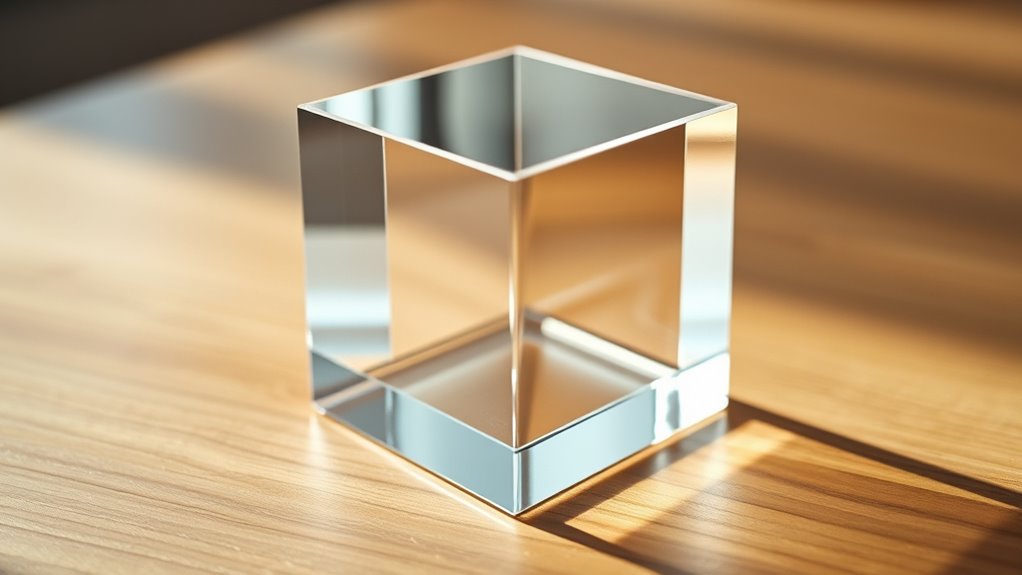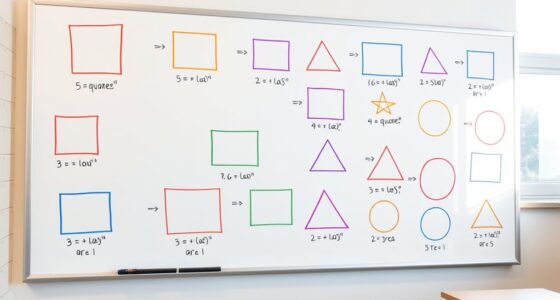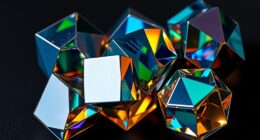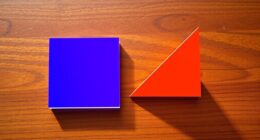To calculate the volume and surface area of 3D objects, you need to know the shape’s specific formulas. For cubes and rectangular prisms, multiply length, width, and height for volume, and add all face areas for surface area. Cylinders, cones, spheres, and pyramids each have their own formulas involving radius, height, and π. Mastering these calculations helps in precise measurement and design—continue exploring to learn how to apply these formulas accurately across various shapes.
Key Takeaways
- Understand formulas for volume and surface area of basic shapes like cubes, cylinders, cones, pyramids, and spheres.
- Break complex objects into simpler geometric figures to calculate total volume and surface area accurately.
- Use coordinate geometry and 3D graphing techniques to visualize and verify measurements of objects in space.
- Incorporate precise measurements with calibrated tools and consistent units to ensure calculation accuracy.
- Apply these calculations in practical contexts such as material estimation, design, engineering, and optimization.
Understanding the Basics of Volume and Surface Area

Understanding the basics of volume and surface area is essential for grasping how three-dimensional objects occupy space. When you explore these concepts, you often use coordinate geometry to understand the position and dimensions of shapes in space. 3D graphing allows you to visualize objects like cubes, cylinders, and spheres, making it easier to see their volume and surface area. By plotting points and equations on a three-dimensional coordinate system, you get a clearer picture of how different shapes extend in space. This visual approach helps you develop intuition about how size, shape, and position affect the amount of space an object takes up and how much surface is exposed. Additionally, understanding how to calculate these properties is fundamental for applications in engineering and design, including Volkswagen tuning, where modifications involve precise measurements of engine components and body parts. Mastering these basics sets the foundation for more complex calculations and real-world applications.
Calculating the Volume of Cubes and Rectangular Prisms

To find the volume of a cube or rectangular prism, you multiply its length, width, and height. For cubes, all edges are equal, so you only need the edge length. Rectangular prisms may have different measurements, but the process remains the same. If you know the diagonal measurement, you can find the edge length using the Pythagorean theorem. Understanding the geometry of 3D objects helps clarify how these measurements relate to each other.
Determining the Surface Area of Cubes and Rectangular Prisms

Once you’ve calculated the volume of a cube or rectangular prism, it’s equally important to determine its surface area. To do this, you’ll need to examine the rectangular faces and the cube edges. For a cube, all edges are the same length; multiply the area of one face (edge squared) by six. For rectangular prisms, identify the length, width, and height, then calculate the area of each pair of rectangular faces. Add these areas together to find the total surface area. Remember, each face’s area is found by multiplying the dimensions of its edges. This process helps you understand how much material covers the object’s surface, which is essential in real-world applications. Accurate surface area calculations give you a complete picture of the object’s external size.
Volume and Surface Area of Cylinders
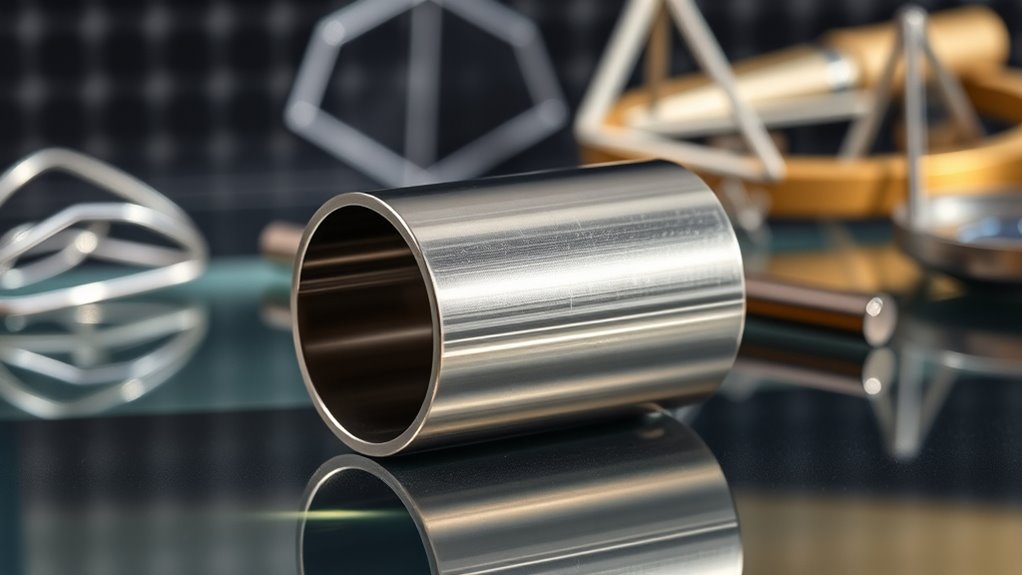
Now, you’ll learn how to find the volume of a cylinder using the formula (V = pi r^2 h), where you multiply the base area by the height. You’ll also explore how to calculate the surface area, which includes both the sides and the top and bottom circles. Mastering these formulas helps you understand the space a cylinder occupies and how much material is needed to cover it.
Cylinder Volume Formula
Ever wonder how to find the volume of a cylinder? The formula is straightforward: multiply the area of the base by the cylinder height. The base is a circle, so its area is π times the radius squared. The volume formula becomes:
| Parameter | Description | Example |
|---|---|---|
| Base area (A) | πr² | π × 3² = 28.27 |
| Cylinder height (h) | Distance between bases | 10 units |
| Volume (V) | A × h | 28.27 × 10 = 282.7 |
Here, the cylinder height directly scales the base area, giving you the total space inside. Remember, the lateral surface isn’t part of the volume, but it’s key for surface area calculations. Additionally, understanding the surface area of a cylinder helps in designing custom projector screens to optimize reflectivity and image quality.
Surface Area Calculation
To find the surface area of a cylinder, you need to contemplate both the area of its sides and the top and bottom circles. The surface area calculation involves measuring the lateral surface area and the areas of the two circular ends. To do this, you use measurement techniques such as calculating the circumference of the base and the height of the cylinder. The lateral surface area equals the circumference times the height, while each circle’s area is π times the radius squared. Add these together: the lateral surface area plus twice the area of a circle, giving you the total surface area. Using these measurement techniques, you can determine the complete surface area of any cylinder accurately.
Calculating the Volume of Cones and Pyramids

To find the volume of cones and pyramids, you’ll need to understand their specific formulas. The cone volume formula involves the base area and height, while pyramids require dividing the base area by three. Mastering these calculations helps you accurately determine their space within any structure.
Cone Volume Formula
Have you ever wondered how to find the volume of a cone or pyramid? To calculate a cone’s volume, you’ll need the cone height and the base radius. The formula is straightforward: ( V = frac{1}{3} pi r^2 h ). Imagine a cone standing upright, with its pointy tip and circular base.
- The cone height is the vertical distance from the base to the tip.
- The slant length is the length along the cone’s side from the base to the tip, which isn’t used in the volume formula but helps in other calculations.
- The base radius is the distance from the center to the edge of the circle.
- The volume represents how much space the cone occupies.
Using these elements, you can easily determine the cone’s volume.
Pyramid Volume Calculation
Calculating the volume of a pyramid involves understanding its shape and key measurements. You need to know the pyramid height, which is the perpendicular distance from the base to the apex, and the base area. To find the volume, use the formula: (1/3) × base area × pyramid height. The slant edge length, which is the diagonal from the apex to the midpoint of a base side, helps determine the pyramid’s lateral surface but isn’t directly used in volume calculations. Ensuring you have accurate measurements of the pyramid height and base area is vital for precise results. Once you have these, applying the formula is straightforward. This calculation gives you a clear understanding of the pyramid’s capacity, essential for many practical applications.
Surface Area of Cylinders, Cones, and Pyramids

Ever wondered how to find the surface area of cylinders, cones, and pyramids? To calculate these, you need to understand their shape components. Here’s what to regard:
- For cylinders, add the areas of the two circular bases and the curved surface, which depends on the cylinder height.
- For cones, include the base area and the lateral surface, using the cone slant height to find the sloped side area.
- Pyramids involve summing the base area and the triangular faces, which vary based on the pyramid’s shape.
- Visualize unwrapping each shape’s surface to see how the flat shapes combine to form the 3D object.
- Incorporating visual cues can help in understanding the surface components more clearly.
Knowing these elements helps you accurately compute surface areas for each shape.
Volume and Surface Area of Spheres

Did you know that a sphere’s volume and surface area can be calculated with simple formulas involving its radius? The sphere properties are straightforward: the volume equals (frac{4}{3} pi r^3), and the sphere surface area is (4 pi r^2). These formulas make it easy to find how much space the sphere occupies and how much material covers its surface. To calculate the volume, you need the radius, which is the distance from the center to any point on the surface. The surface area tells you the total area that forms the outside of the sphere. Knowing these properties helps you understand the size and shape of spherical objects, whether they’re planets, balls, or bubbles. Understanding geometric formulas is essential for applying these calculations in various fields, including engineering and design. These calculations are fundamental in geometry and real-world applications.
Exploring the Volume and Surface Area of Composite Shapes

When working with composite shapes, you’ll combine the volumes of individual parts to find the total volume. Calculating surface area involves adding the areas of each surface, but you also need to account for shared edges. Understanding these processes helps you accurately determine the space and surface of complex objects. Additionally, paying attention to detachable parts and their properties can simplify the calculations.
Combining Shape Volumes
To find the volume and surface area of a composite shape, you need to break it down into simpler, individual shapes. Shape integration involves adding the volumes of each part to get the total volume. When doing a volume comparison, consider how the parts fit together and whether they overlap or are separate. Visualize stacking blocks, cylinders, or spheres to form your shape. For example:
- Combining a cylinder with a cone on top
- Layering a cube inside a larger box
- Merging a sphere and a rectangular prism
- Connecting different shapes to form a complex figure
Calculating Surface Area
Calculating the surface area of composite shapes requires breaking the figure into individual parts and then summing their surface areas while accounting for overlaps or hidden surfaces. In art, understanding surface area helps in applying textures or finishes accurately, while in engineering, it’s essential for material estimation and heat transfer analysis. To find the total surface area, measure each component’s surface area separately, then subtract any overlapping or internal surfaces that aren’t visible. For complex shapes, consider dividing them into basic geometric figures like cylinders, cones, or prisms, and sum their surface areas accordingly. This method ensures precision, whether you’re working on artistic sculptures or engineering prototypes. Additionally, retail hours information can be useful for planning visits to stores while working on projects that require materials or supplies. Accurately calculating surface area enables better design, material planning, and real-world application.
Practical Applications of Volume and Surface Area Calculations
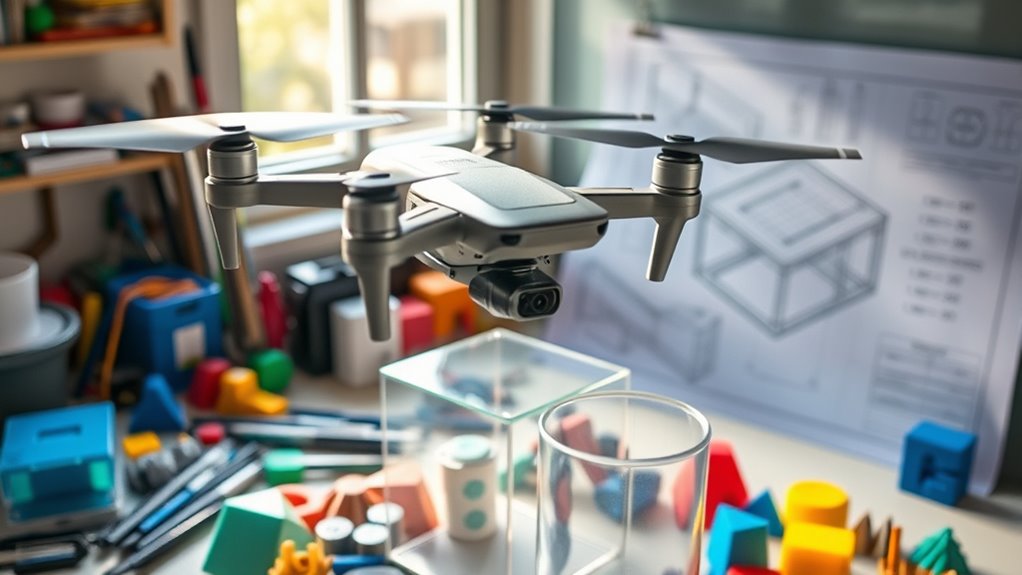
Understanding how to calculate volume and surface area has real-world significance across many industries. You use these skills in mathematical modeling to predict how objects behave under different conditions. In architectural design, accurate volume calculations ensure buildings are safe and efficient, while surface area helps determine material needs. For example, you might:
- Design water tanks with precise capacities
- Plan insulation for energy efficiency
- Estimate paint or coating requirements on surfaces
- Create realistic models for construction projects
- Apply tuning techniques to optimize vehicle performance and efficiency
Tips and Tricks for Accurate 3D Measurement Calculations
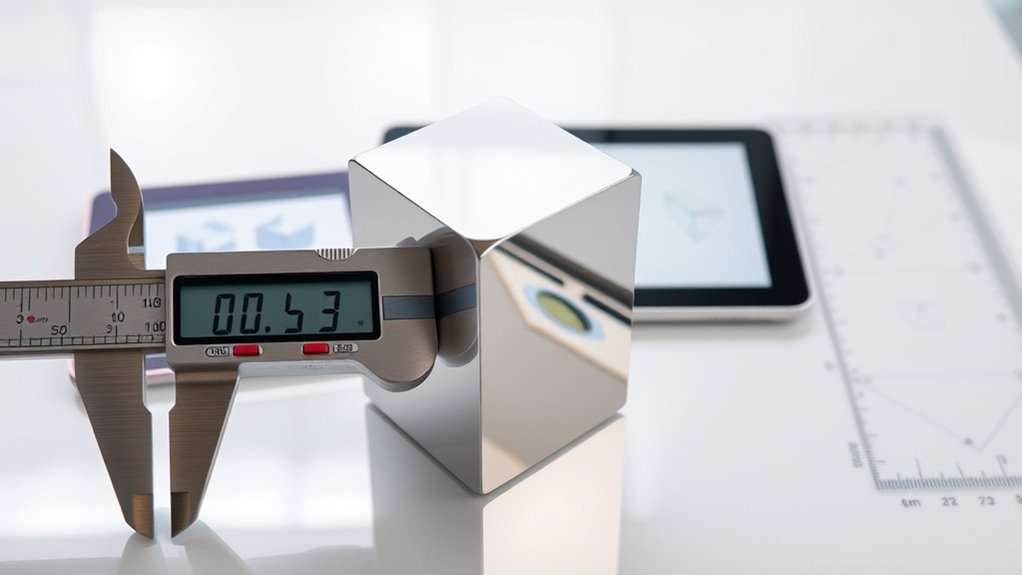
Accurate 3D measurements are essential for reliable volume and surface area calculations, and mastering key techniques can substantially improve your results. When working with 3D printing models, guarantee your measurements are precise by using calibrated tools like digital calipers. Double-check dimensions, especially for complex shapes, to avoid errors. Remember that material density affects your calculations when estimating weight or strength, so use accurate density values to refine your results. Maintain consistent units and double-check measurement points to minimize mistakes. Incorporate software that allows precise modeling and measurement adjustments. Taking these extra steps helps you avoid inaccuracies, especially when calculating volume or surface area for different materials. Understanding the Kia Tuning options can also influence material choices and design considerations. Clear, precise measurements lead to better 3D printing outcomes and more reliable data overall.
Frequently Asked Questions
How Do Irregular Shapes Affect Volume and Surface Area Calculations?
Irregular shapes make volume estimation and surface area calculations more challenging because their sides and curves are not uniform. You need to break the shape into smaller, regular parts or use approximation methods like water displacement or grid methods. These techniques help you get a more accurate estimate of the volume and surface area, even when dealing with complex, irregular shapes. This approach simplifies the calculation process for irregular objects.
What Tools Are Best for Measuring Complex 3D Objects Accurately?
For measuring complex 3D objects accurately, you should consider using digital calipers and 3D scanners. Digital calipers are great for precise measurements of smaller, detailed features, while 3D scanners capture the entire shape quickly and accurately. Combining these tools allows you to get detailed measurements and complete surface data, ensuring your calculations of volume and surface area are as accurate as possible for irregular shapes.
How Does Scale Impact Volume and Surface Area in Models?
Scale effects substantially impact model proportions, influencing both volume and surface area. When you increase a model’s scale, its volume grows faster than its surface area because volume scales with the cube of the scale factor, while surface area scales with the square. This means larger models appear more massive relative to their surface area, affecting how you interpret their proportions and realism in various applications.
Can Volume and Surface Area Calculations Be Automated?
Imagine simplifying your work by automating complex calculations. You can definitely do this with current tools, as automation feasibility is high for calculating volume and surface area. Using specialized software or coding methods streamlines the process, reducing errors and saving time. These calculation methods are accessible and effective, making it easy for you to handle multiple objects quickly while ensuring accuracy in your measurements.
How Are Volume and Surface Area Relevant in Environmental Design?
You see, in environmental design, understanding volume and surface area helps you create sustainable architecture. By calculating these, you optimize space and energy use, reducing environmental impact. Using green building materials becomes more effective when you know the building’s surface area for insulation and the volume for efficient climate control. This integration guarantees your designs are eco-friendly, energy-efficient, and sustainable, aligning with modern environmental goals.
Conclusion
Understanding how to calculate volume and surface area helps you grasp the size and space of 3D objects. Did you know that a sphere’s surface area is about 12.57 times its radius squared? Mastering these concepts lets you accurately measure real-world objects, from packaging to architecture. Keep practicing, and you’ll confidently handle any shape’s measurements—making your projects precise and efficient.
